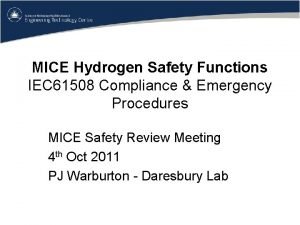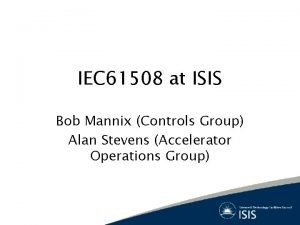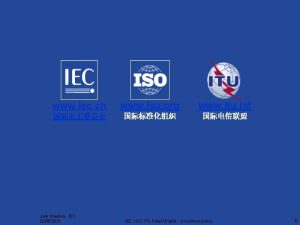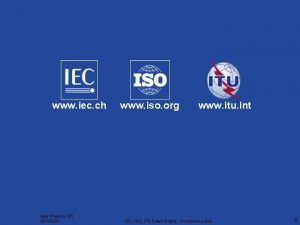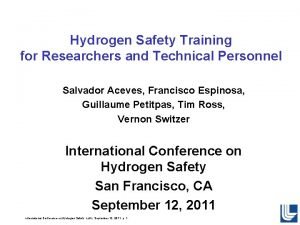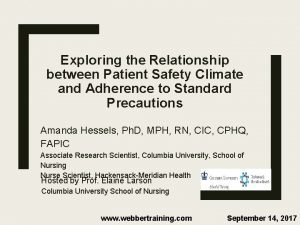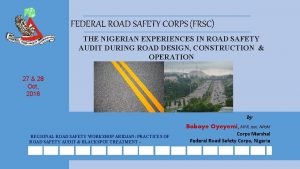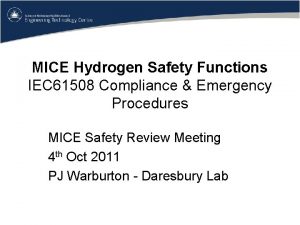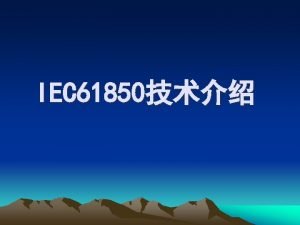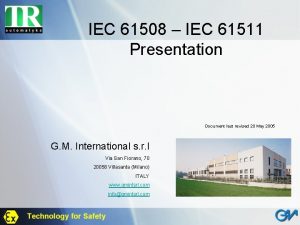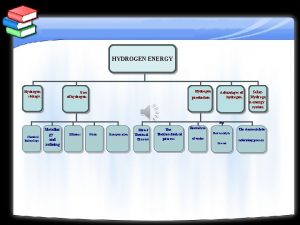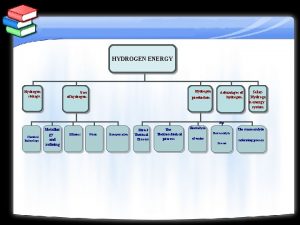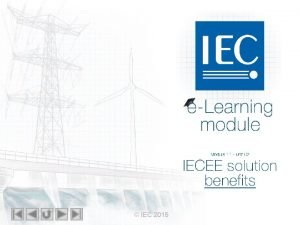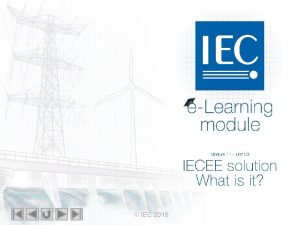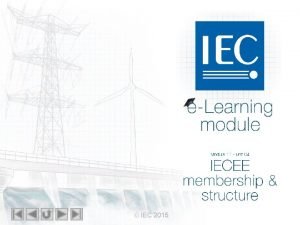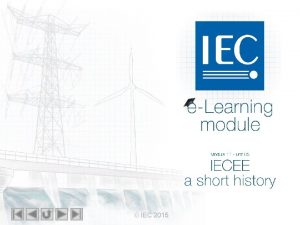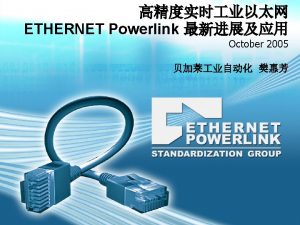MICE Hydrogen Safety Functions IEC 61508 Compliance Emergency













- Slides: 13

MICE Hydrogen Safety Functions IEC 61508 Compliance & Emergency Procedures MICE Safety Review Meeting 4 th Oct 2011 PJ Warburton - Daresbury Lab

IEC 61508 • Functional Safety of electrical / electronic / programmable electronic safety – related systems • Functional safety is part of the overall safety that depends on a system or equipment operating correctly in response to its inputs • Neither safety nor functional safety can be determined without considering the systems as a whole and the environment with which they interact • Safety – The freedom from unacceptable risk of harm

SIL Rating • Tolerable Risk 10 -5 Fatalities per Year From RAL Safety • How Safe is H 2 System 10 -4 10 -3 10 -2 SIL 1 PFD 10 -1 SIL 2 PFD 10 -2 SIL 3 PFD 10 -3

IEC 61508 Compliance Process • LOPA Study conducted Nov 2010 based on HAZOP Report from Serco June 2006 • Panel consisted of representatives from FSC, MICE project at RAL & DL and RAL Safety • Identified 2 Systems requiring SIL Functions • Plus 2 to be considered but not requiring formal SIL Ratings

SIL Rated Safety Functions • Following LOPA study the following events were found to require SIL rated safety systems • Buffer Tank Over Pressure • Leading to a release of hydrogen and ignition leading to multiple deaths • Build up of impurities in Cryostat (Ins Vac) • Build up of impurities over a period of time, pressurisation and heating of hydrogen leading to a rupture & Explosion leading to multiple deaths

Not Quite SIL Rated • Following LOPA study the following events were found Not to require SIL rated safety systems • Hydride Bed Over Pressure • Over heating of Metal Hydride Bed Leading to a release of hydrogen and ignition leading to multiple deaths • Temperature Rise in Absorber Volume • Causing pressurisation and heating of hydrogen leading to a rupture & Explosion leading to multiple deaths • Same outcome as Buffer Tank Over Pressure

Buffer Tank Over Pressure • Build up of pressure causing leaks in pipework and Hydrogen to escape • SIL 1 Required PFD 1. 00 E-01 (1 out 10) • • • Solution detect the H 2 before it reaches explosive levels Install a gas Detection System alarm 50% LEL 2 Detectors / Beacons per location on separate loops Detection system subject to annual checks PFD Achieved 1. 51 E-02 (<2 out 100) = SIL 1 • • PFD = Probability of Failure on Demand H 2 LEL = 4%

SIL Block Diagram

Build up of impurities in Cryostat (Insulation Vacuum) • Over time Cryostat insulation vacuum may build up impurities. - O 2 Leaking In – H 2 Leaking Out • Depending on Temperature / Pressure an Explosive atmosphere may form • Temp & Level Sensors are Ex i • Heaters are not so operation needs to be prevented if vacuum is not good – below 10 -3

Build up of impurities in Cryostat (Insulation Vacuum) • SIL 2 Required PFD 6. 73 E-03 (~7 out 1000) • • Solution interlock heater power supply Use 1 Set Point on existing Vac Gauge & Controller Additional Set Point from new Vac Gauge & Controller Guard Line A & B Relays to turn of heater power supply Hardwired I/L • Guard Line A & B inputs also into PLC for Software I/L • PFD Achieved 3. 76 E-03 (~4 out 1000) = SIL 2

SIL Block Diagram

Emergency Actions • Return hydrogen to Bed if possible • Vent hydrogen to atmosphere via vent line • IF PLC goes off – Vacuum pumps stay on – Hydride Bed set to ‘chill’

Questions
 Iec 61508 compliance
Iec 61508 compliance 61508
61508 Www.iec.ch
Www.iec.ch Http://www.iec.ch
Http://www.iec.ch Hydrogen safety training
Hydrogen safety training National safety compliance quiz answers 11-013
National safety compliance quiz answers 11-013 Which display mode is allowed for proper navigation?
Which display mode is allowed for proper navigation? Safety care training
Safety care training Personal safety vs process safety
Personal safety vs process safety Ind safety report
Ind safety report Basic safety (construction site safety orientation)
Basic safety (construction site safety orientation) Construction site safety orientation
Construction site safety orientation Functions of federal road safety corps
Functions of federal road safety corps Ground bond testing
Ground bond testing
